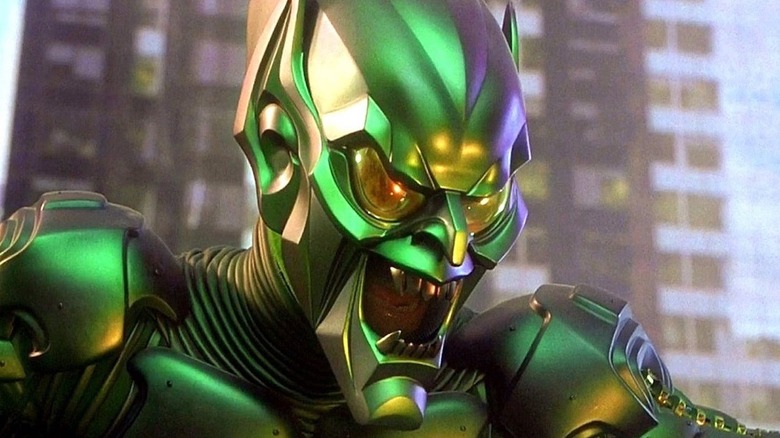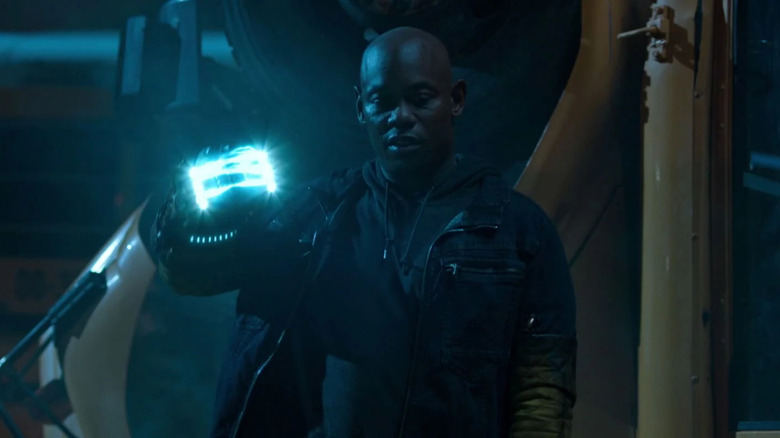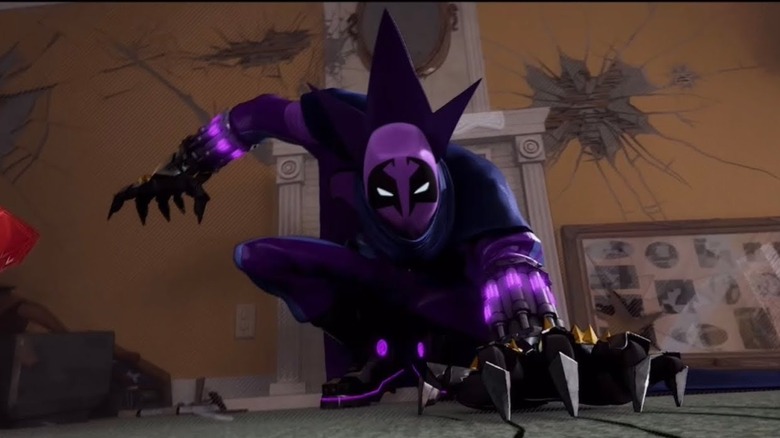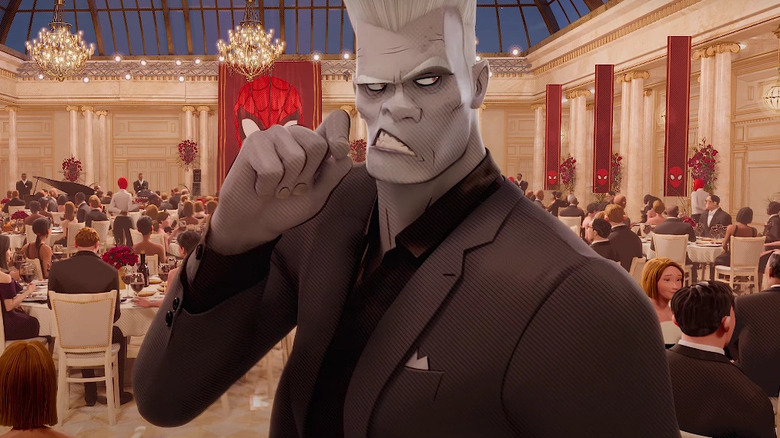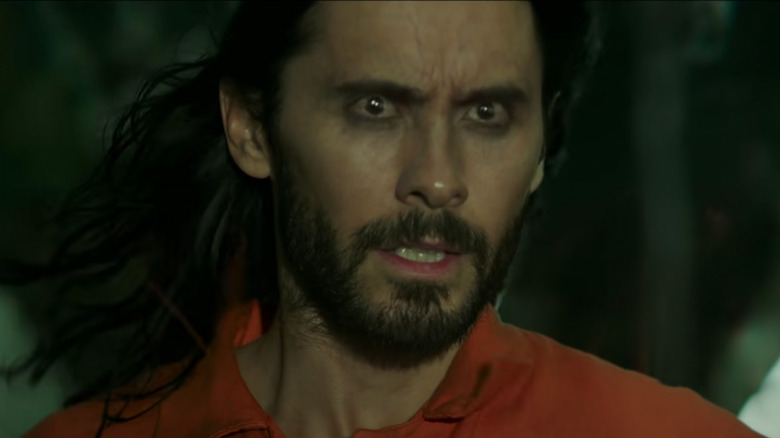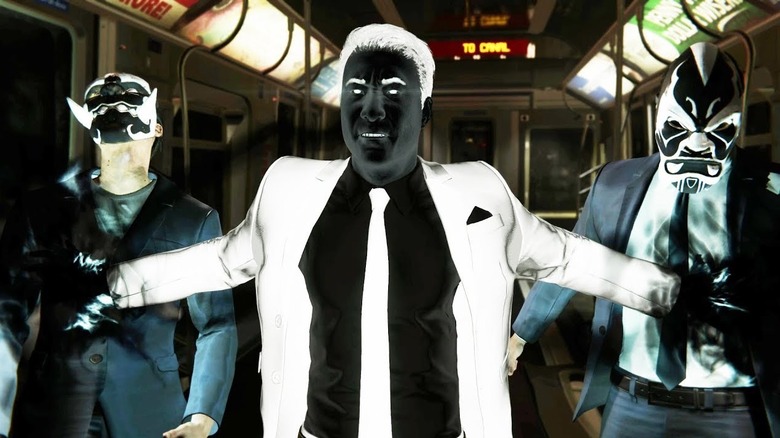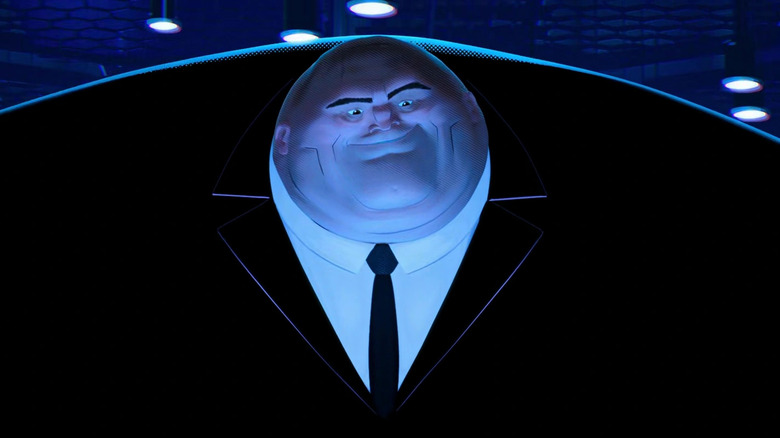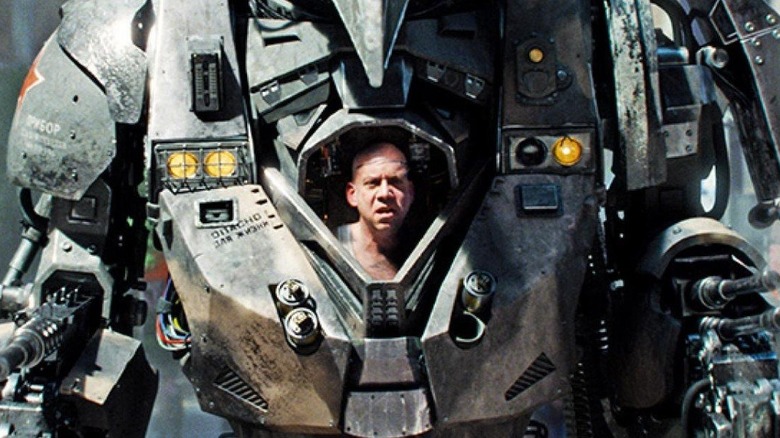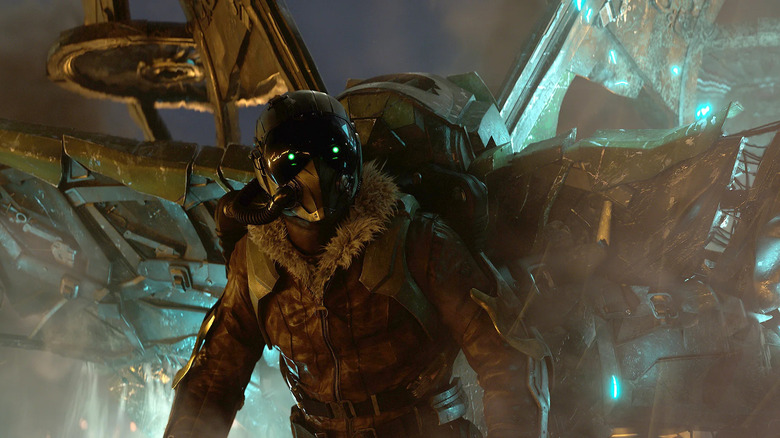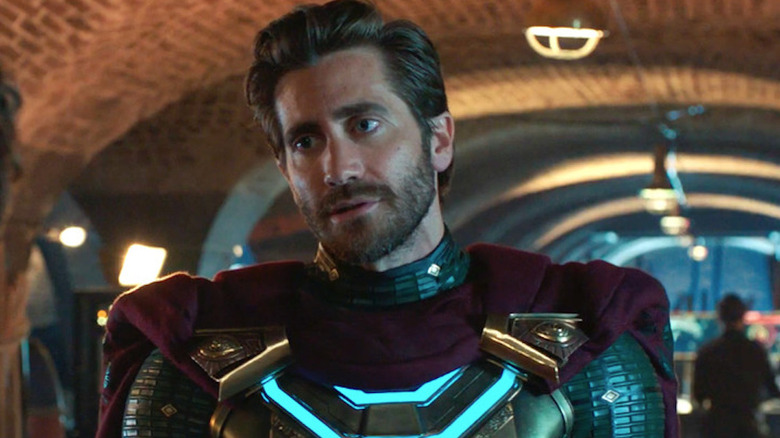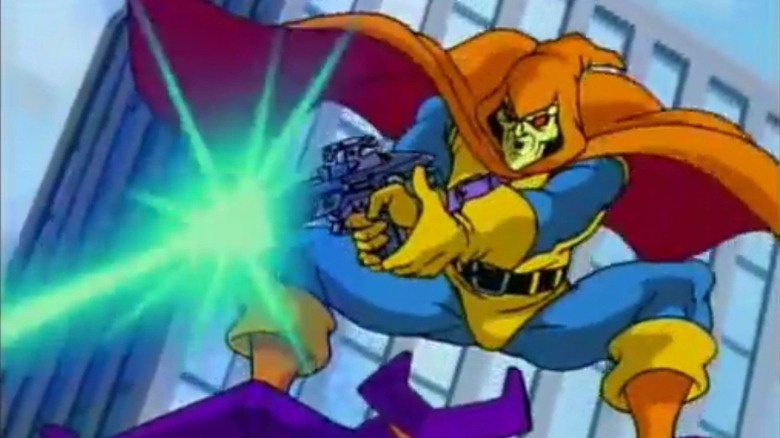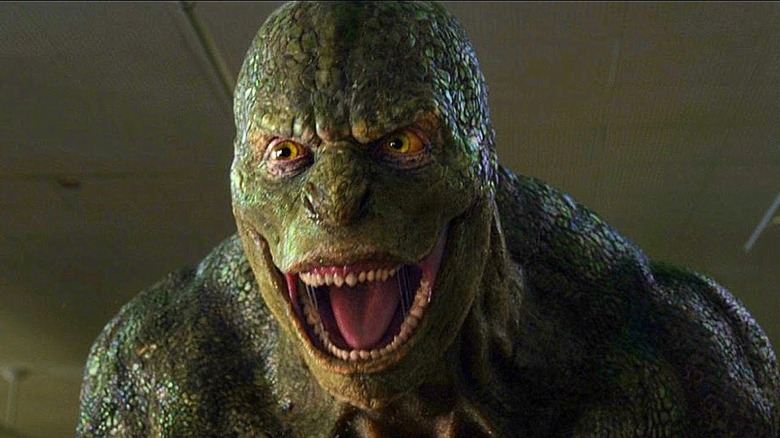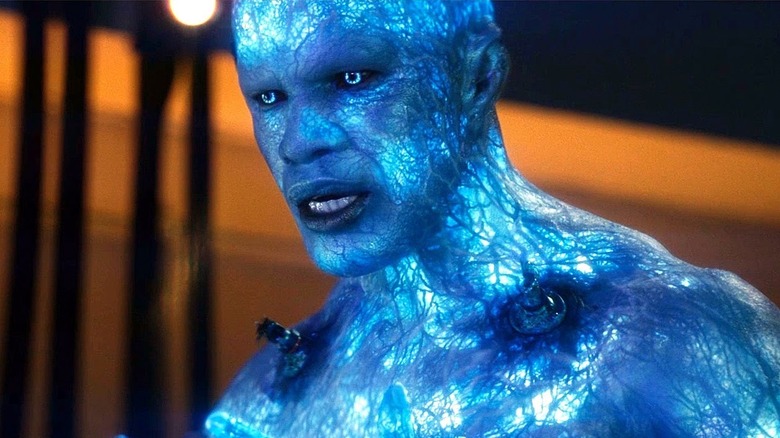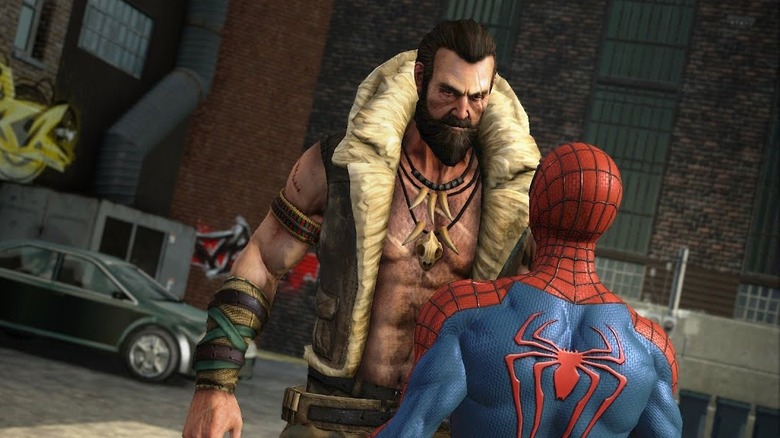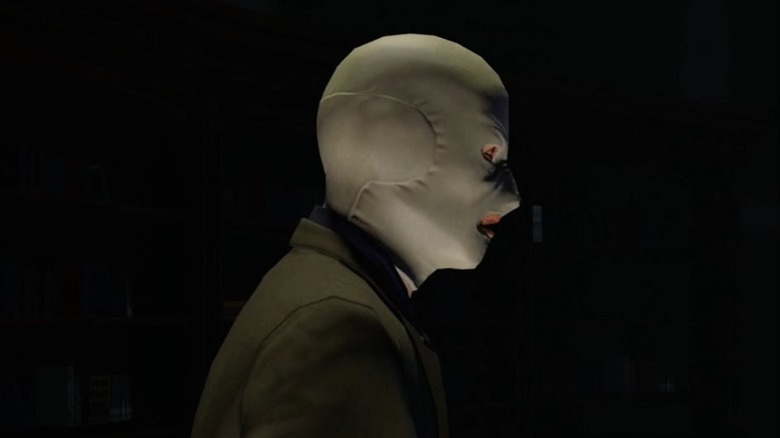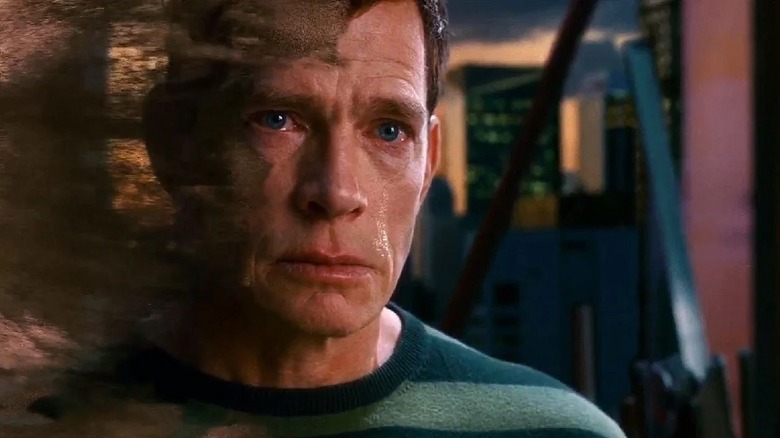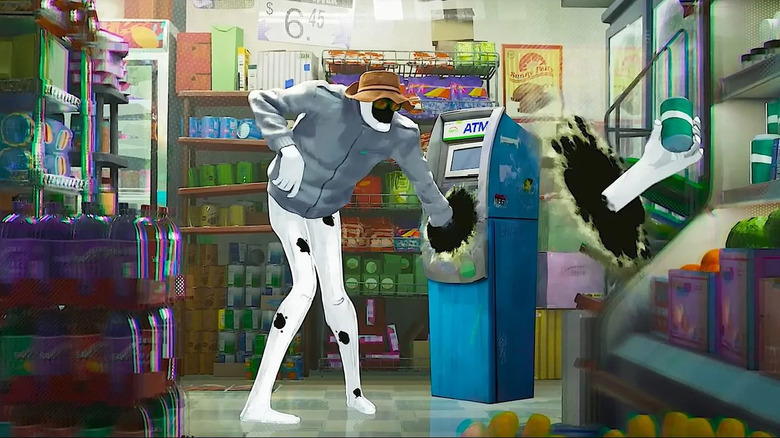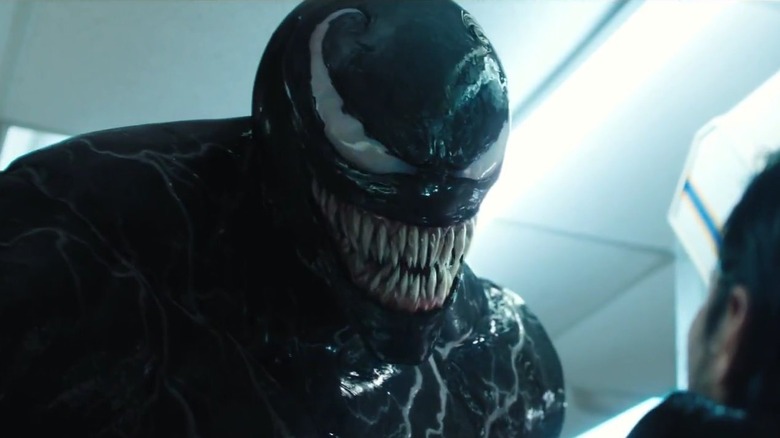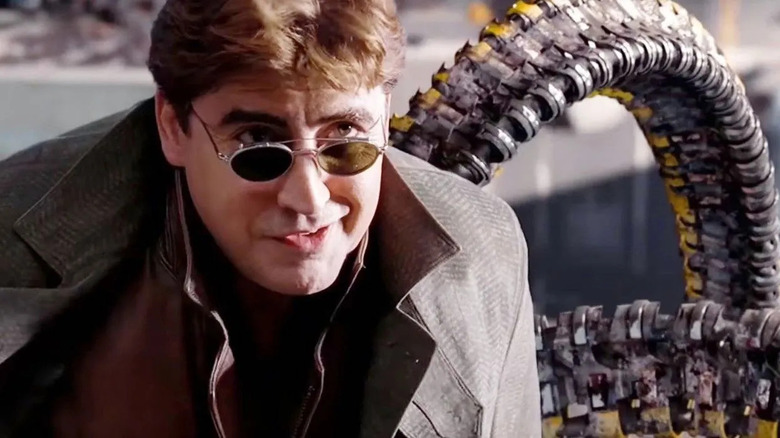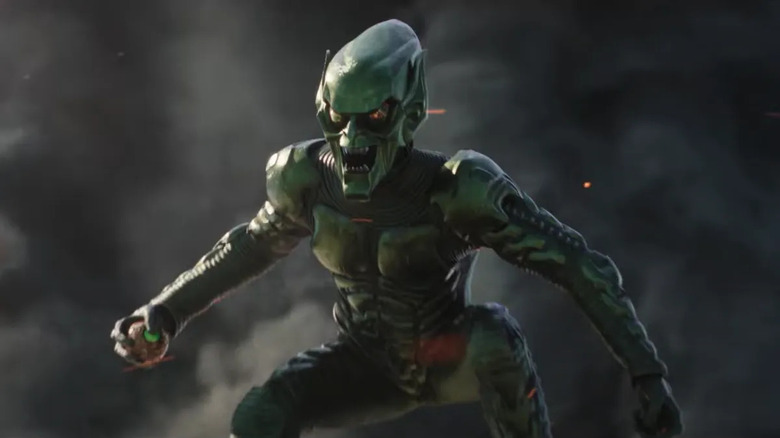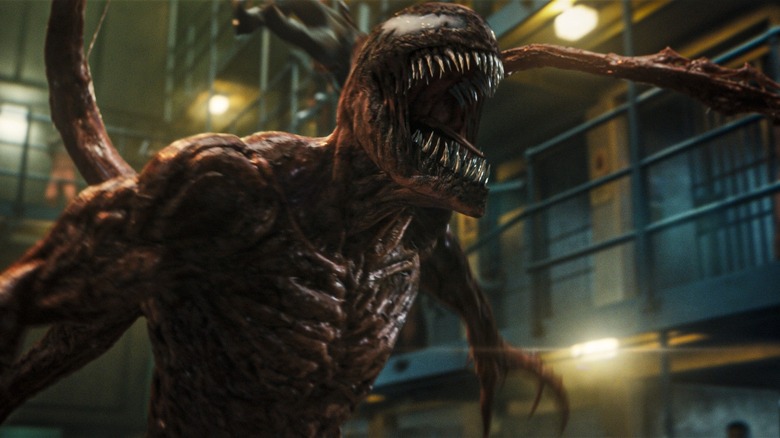The Most Powerful Spider-Man Villains Ranked
Even audiences who don't follow comic books movies know that there have been a lot of "Spider-Man" films released in the last two decades. The character audiences first met in 1963's "The Amazing Spider-Man #1" has had a long and prolific life in comics, video games, and since the turn of the millennium, on the big screen. The Peter Parker version of Spider-Man alone has been played by three actors — Tobey Maguire, Andrew Garfield, and Tom Holland — all of whom appeared in 2022's "Spider-Man: No Way Home" in some narratively effective fan service. The animated "Spider-Verse" franchise centers around Miles Morales, with more alternate universe Spider-People in his orbit than one can easily count.
Such a culturally predominant hero needs villains befitting his status and popularity, and Spider-Man might just have more iconic enemies than any other character on Marvel (and Sony's) roster. Some are street-level criminals Spidey tussles with while keeping his New York City neighborhood safe. Some are regular people and even former allies made bitter by their sad backstories. Some are victims of experiments gone wrong. And some are all of the above. Their powers and abilities range from basic villain fare to the absurdly specific. Worse yet for Spider-Man, his many foes are known to team up with one another. But who's the most fearsome of the bunch? Who does Spider-Man least want to run into in a dark alley or a dark corner of the Spider-Verse? Taking into account the many variations of each villain across multiple platforms, this is how Spidey's most common enemies stack up from least to most powerful.
20. Shocker
Herman Schultz, or Shocker, is a Spider-Man villain who dates back to 1967's "The Amazing Spider-Man #46." Like many more Spidey foes who will appear on this list, Shultz was a smart kid in a bad situation, a sort of cautionary tale about what Peter Parker could've become. He dropped out of high school and became a thief, thug-for-hire, and inventor of super gadgets despite having no formal education or training. His defining characteristic is the pair of gauntlets he engineers that can be used to (among other things) disable enemies and crack safes. The devices release high-powered blasts of air, or shockwaves, that vibrate at a high frequency and are operated with triggers. Schultz wears a super suit that's designed to absorb the residual energy from these blasts.
But, unlike many more Spidey foes who appear on this list, Shocker doesn't really have strong feelings about Spider-Man. He just sees doing crime as a way to become wealthy and powerful, and sometimes it's Spider-Man standing in his way. It's also not always Herman Schultz wearing the gauntlets. In 2017's "Spider-Man: Homecoming," there were not one but two Shockers, each armed with one shock-inducing apparatus. Bokeem Woodbine is credited as Herman Shultz/Shocker #2, while Logan Marshall-Green is credited as Jackson Brice/Shocker #1. Michael Keaton's Vulture accidentally kills Brice, at which point Schultz gets promoted. To be fair, Peter Parker does have to be bailed out by Iron Man in his run-in with Shocker. Still, he's not a top-tier villain; more of a one-trick pony with surface-level motivations.
19. Prowler
Multiple human characters have donned the suit and secret identity of the Prowler, too. In fact, one of them — Aaron Davis — is rescued by Spidey during that confrontation with the Shockers and Vulture in "Spider-Man: Homecoming." Davis, the criminally-inclined uncle of Miles Morales, is revealed to be Prowler in 2019's "Spider-Man: Into the Spider-Verse," where he's voiced by Mahershala Ali. The first Prowler, however, was Hobie Brown, who made his debut in 1969's "The Amazing Spider-man #78." A Black teenager from the Bronx, he's another wayward tech genius who became Prowler so that he could commit petty crimes. An alternate version of Hobie becomes Spider-Punk, who we meet in "Spider-Man: Across the Spider-Verse," voiced by Daniel Kaluuya.
Prowler has factored more heavily into Spidey stories lately, though he's really just a regular guy with mid-level ambitions in a mid-level (albeit multifaceted) super suit ... which gives him more versatility than Shocker. The Prowler costume is typically outfitted with darts, gas, flares, air blasters, cleaning fluid, and a cape for good measure. Metal claws and pneumatic boots come in handy when scaling walls or running on rooftops in pursuit of Spider-Man. Prowler is also a martial arts enthusiast, which helps in close combat situations, especially considering the fact that neither Hobie Brown nor Aaron Davis have actual superpowers. Most variations of the character redeem themselves at some point, usually (as is the case with Miles and his uncle) through their interactions with Spider-Man. The last act reveal that Earth-42's Miles Morales is Prowler instead of Spider-Man, however, promises to complicate the character's legacy in a fascinating way.
18. Tombstone
In the comics, Tombstone has been around since the 1980s, but he made his film debut with a small role in 2019's "Spider-Man: Into the Spider-Verse." The character was, of course, animated, and voiced by Marvin Jones III. Born Lonnie Lincoln in Harlem, the man who came to be known as Tombstone was an albino African-American kid in a predominantly Black society. This made him a target for bullies, and Lonnie — who was taller, bigger, and stronger than the other kids — became a bully in his own right in response to his torment. He quickly pivoted to a life of crime. Like Prowler, he's often in the employ of Kingpin.
Tombstone doesn't have gear and gadgets on the scale of Shocker or Prowler, but he doesn't necessarily need them. He's huge, which makes him a great heavy in and of itself, as do his years of experience brawling on the streets and handling firearms. Tombstone doesn't have to wear a mask to be intimidating. He's been known to file his teeth into points, and his albinism in the comics comes with mutations such as near-bulletproof skin and resilience to extreme temperatures that nudge him into true super-villain territory, despite the fact that he's never really more than a henchman.
17. Morbius
Today, most audiences probably know Dr. Michael Morbius from the much-maligned 2022 film starring Jared Leto in the title role. That film had so little to do with Spider-Man, a shot in the trailer that depicted a mural of Spider-Man with the word "MURDERER" tagged over it was cut from the movie itself. But Morbius is nevertheless one of the anti-heroes in Spidey's social circle, and he has been since he first appeared in "The Amazing Spider-Man #101." While villains like Prowler and Shocker adhere to one common "Spider-Man" trope (misunderstood and underprivileged geniuses who use tech to give themselves alter egos), Dr. Michael Morbius hews closely to another: The tragic victim of circumstance who unwittingly becomes superhuman. He transforms into Morbius the Living Vampire because his attempts to cure his rare blood disease through dangerous experiment radiation accidentally bestow upon him vampiric qualities.
Because he's got a foot in the human and the undead worlds, those qualities function somewhat like mutations. Morbius has enhanced senses, increased strength, regenerative powers, and the ability to hypnotize others, as well as razor-sharp claws and fangs. And that's all on top of his already superior intellect. But his power set isn't quite as strong as a true vampire's would be, and he's not always in total control of himself. He's also not explicitly evil, like some of the villains on this list. His bloodlust has more to do with survival and he often kills because he has no other choice. You wouldn't want to be on Morbius' bad side, but Spidey has bigger problems than the cursed doctor.
16. Mister Negative
A relatively recent addition to Spider-Man's litany of adversaries, Mister Negative was first developed for a 2007 Free Comic Book Day issue. He went on to appear in more Marvel Comics stories, and most notably, he became one of the primary bad guys in 2018's PlayStation 4 game, "Marvel's Spider-Man." The character's visual design is admittedly a little thematically obvious. In his everyday life, Mister Negative is actually Martin Lin, a Chinese immigrant who makes a vast fortune in America and starts a charity to help out the hungry and homeless. That nonprofit, F.E.A.S.T. (Food, Emergency Aid, Shelter, and Training), pops up in "Spider-Man: No Way Home," though Martin Lin himself does not. But Lin has a dark side. As Mister Negative — a literal photo-negative version of himself — he's the crime boss of a gang known as the Inner Demons.
Like a monochromatic Dr. Jekyll and Mr. Hyde, Martin Lin sometimes doesn't realize he's also Mister Negative. He became his bifurcated self after a chemical mishap at Oscorp. The resulting transformation rendered him able to control Darkforce and Lightforce energy. He has the power to corrupt others by mere touch, he can shape-shift to an extent, and his increased strength and resilience make him more challenging for Spider-Man to take down. Martin Lin is also multilingual and gifted at running enterprises, whether they're altruistic or nefarious.
15. Kingpin
Wilson Fisk, better known by his mafioso nickname Kingpin, isn't just one of Spider-Man's most infamous enemies: He's one of the heaviest hitters in the entire Marvel Comics universe. Fisk went from being a poor kid in New York City who was teased for being overweight to the metropolis' most feared crime boss who uses his massive size to intimidate his underlings and anyone who dares oppose him. Kingpin also uses his political acumen, not to mention a moral relativism that often spills over into outright cruelty, to stay at the top of NYC's ladder of power.
The character has been played by Vincent D'Onofrio in Netflix's "Daredevil" and in Disney+'s "Hawkeye." He'll reprise his role again in the upcoming "Echo" series and "Daredevil: Born Again." D'Onofrio's portrayal is of an emotionally complicated but problematic Godfather-like figure who can both psychologically and physically strong-arm his opponents. But the character has never been more enormous than in "Spider-Man: Into the Spider-Verse," where his body is so inhumanely large, it rarely all fits within the box of the screen. Though Kingpin doesn't appear in "Spider-Man: Across the Spider-Verse," he looms as a foreboding presence in multiple universes. Despite his bulk and the fact that he's protected by hired goons, Fisk is more than capable of holding his own in a fight. But — and this is a big but — he doesn't have any superpowers, and his weapon of choice is a walking stick (that's secretly an energy blaster, but still). It's the unrivaled soft power that Fisk has accumulated over the years that gives him so much clout.
14. Rhino
If power meant strength, then Rhino could've well topped this list. But there are myriad ways for heroes and villains to achieve their goals, and brawn is only one of them. Aleksei Sytsevich is a Spider-Man and Hulk foe who dates back to 1966. He's a Russian mobster who willingly signed up to become a test subject for an experiment, the point of which was to give him armor-thick skin. Later, the same gamma rays that made Bruce Banner the Hulk are used on Sytsevich to try to make him a worthy nemesis. Rhino does get even stronger (it's estimated he can lift 75 tons), but he's still no match for the big green guy. And regardless of his size, durability, and surprising speed, he's rarely a match for Spider-Man. That's because the friendly neighborhood crime fighter figures out he's not very good at changing directions once he charges and — there's really no polite way to put this — he's just not very smart.
Rhino's reputation took another hit with 2014's "The Amazing Spider-Man 2." Paul Giamatti played Sytsevich in a supporting role as a Russian thug who teams up with Harry Osborn and who wears a poorly designed and pretty obviously CGI mech suit, calling himself the Rhino. Fans didn't love this version of the character, and it's widely thought to be one of the weakest of Spidey's many on-screen villains. More compelling Rhinos have appeared in comics and video games, but this rogue could use more on his resume than just scientifically enhanced muscle.
13. Vulture
Vulture (in contrast to someone like Rhino) is a character who's only gotten more interesting each time he shows up in Spidey's story. A Leonardo Da Vinci-style two-dimensional version of him kicks off the action in "Spider-Man: Across the Spider-Verse," when Gwen Stacy has to stop the mayhem he's causing at Earth-65's Guggenheim Museum in New York. But he usually starts out as Adrian Toomes, an engineer and salvage shop owner who turns into the vengeful Vulture because of some personal grievances. Toomes and his alter ego were played by Michael Keaton in "Spider-Man: Homecoming." This iteration has it out for Tony Stark and Peter Parker (who, we learn in a chilling scene, happens to be dating his daughter) because he lost his legitimate business thanks to Stark Industries and the Department of Damage Control. Desperate and angry, he becomes a Chitauri technology scrapper and underworld criminal who retains his respectable over-world persona.
Vulture's exo-suit, which is basically a winged harness, contains Chitauri components. That, combined with its manageable size and Toomes' brilliance as an engineer, make him more effective overall than many of Spidey's other self-made human villains. He's well-protected, can fly, and has defensive capabilities like projectiles, plasma pistols, and grenades. The Vulture suit does backfire on Toomes, though, at the end of "Spider-Man: Homecoming," at which point Peter decides to save his then-girlfriend's dad and main antagonist. Vulture isn't the absolute smartest, strongest, or most superhuman character on this list, but he's a nicely-balanced counterpoint to Peter Parker, and Keaton's Adrian Toomes is particularly compelling.
12. Mysterio
Mysterio, also known as Quentin Beck, follows in the proud tradition of Spider-Man villains who started out as scorned humans lacking real superpowers, ultimately innovating new technology-based identities for themselves. Beck was a supposed master of illusions in the comics, and an original member of the Sinister Six. "Spider-Man: Far From Home" tweaks that backstory and makes him an employee of Stark Industries who specialized in holograms and got himself fired. The distinctive-looking character dates back to 1964, and his look remained more or less the same when he served as Peter Parker's primary antagonist, played by Jake Gyllenhaal in the Tom Holland-led film.
As Mysterio, Beck wears a caped super suit decked out with smoke bombs that can create cover for his illusions. But the signature piece of his ensemble is the perfectly spherical plexiglass astronaut-like helmet. He can see out, but no one else can see in. Though he's not actually superhuman in any way, Beck can easily give off the impression that he has superpowers, and pretty incredible ones at that. In "Far From Home," it appears to the crowd in Venice that he's able to take on a Water Elemental. Later, we find out Mysterio was using cutting-edge drones to bend reality, at least from the perspective of innocent bystanders. Even though Mysterio isn't, on paper, as supercharged as some of Spidey's mutant or otherworldly antagonists, sometimes seeing is believing. At the end of "Far From Home," Beck dies, but not before he frames Spider-Man for his murder. Few villains have been able to control Spider-Man's narrative like Mysterio.
11. Hobgoblin
Hobgoblin is sort of like Green Goblin 2.0., combining wearable tech with magic-adjacent substances to create a villain with both super gear and superpowers. Dating back to the 1980s, Hobgoblin is usually the alias of Roderick Kingsley, a corrupt fashion designer who ends up in possession of Norman Osborn's Green Goblin suit. He takes to wearing it himself before eventually designing a new and improved one. He also invents a new and improved Goblin Formula. In the comics and animated television appearances, Hobgoblin is depicted as a more colorful offshoot of Green Goblin. Eventually, he figures out how to fly without a glider and how to tap into his Goblin powers without the need of a mask. But Hobgoblin ranks beneath his predecessor on this list because — though he's capable of evil — Kingsley's not as smart, strong, scheming, or as skilled at combat as his predecessor.
There hasn't been a live-action Hobgoblin yet in any of the "Spider-Man" films. However, there have been rumors that Peter Parker's guy in the chair, Ned (Jacob Batalon), could take on the villain role in a future Marvel Cinematic Universe and Sony project. Ned Leeds is another of Hobgoblin's identities in the comics ... sort of. For many years, Ned was believed to be the real Hobgoblin, but it's revealed that this was simply a ruse by Kingsley, who brainwashed him into acting as a decoy.
10. Lizard
Dr. Curtis Conners has one of the most sympathetic villain origin stories in all of "Spider-Man" lore. Though the details vary depending on the platform, Conners is always a man of science who loses an arm and ends up losing himself in the search for a solution. In 1963's "The Amazing Spider-Man #6," he's a selfless surgeon treating wounded soldiers. In 2012's "The Amazing Spider-Man" film, Conners (Rhys Ifans) is a geneticist who knew Peter Parker's dad. He experiments with lizard DNA with the goal of being able to regenerate his limb. As you might expect, this doesn't go as planned, and he ends up transforming himself into the Lizard, a human-reptile hybrid who compromises his mind and his morals in exchange for a regrown appendage. He plots to turn all of humanity into lizard people after deciding that regular people are too weak.
What makes Lizard so terrifying is that he still has mad scientist-level intellect and ambitions, but in the form of a giant primordial killing machine. Conners doesn't just get his arm back: He's stronger, faster, and more resilient than he was before, with the ability to regrow (or sometimes just grow more) body parts at will. He's got sharp teeth and claws, thicker skin, a muscular tail, and he can match many of Spider-Man's abilities, such as easily scaling buildings thanks to his sticky padded hands and feet.
9. Electro
Electro is another classic Spidey villain who had the misfortune of being crammed into "The Amazing Spider-Man 2," which was already overstuffed with bad guys. Jamie Foxx plays Max Dillon, an introverted, low-level Oscorp employee whose tumble into a tank of electric eels turns him into a living, breathing, and very blue human electrical conductor. Though he was once a Spider-Man fanboy, Dillon dubs himself Electro and endeavors to become Spidey's adversary as a way of making a name for himself. Unfortunately, he does so by causing massive power outages across Manhattan. Peter and Gwen are able to use Electro's superpower against him when so much energy courses through his body, he sort of just disappears. Foxx returned to the role in "Spider-Man: No Way Home" as a redesigned version of the character that better resembles (albeit more realistically) the green and yellow Electro from his earliest comic book appearances.
As Electro, Max Dillion is both superhuman and super powerful (literally — an extreme amount of voltage can surge through his body). Rather than kill him, energy usually makes him stronger. He can manipulate electricity, absorb it, use it as a weapon, and shape it to his will. That power is fairly specific, however, and he's not always in a position to use it, especially in the aftermath of his transformation. Electro is also a B-list villain as far as his schemes go. Though he frequently clashes with Spider-Man and is another founding member of the Sinister Six, Electro can usually be found aligning himself with more A-list talent. He also has an obvious weakness: water.
8. Kraven the Hunter
Another original member of the Sinister Six, Kraven the Hunter has been around as a comic book character since 1964. On the page, he's one of Spidey's most frequent foils. A Russian big game hunter whose full name is Sergei Dimitri Symostivych Kravinoff, Kraven graduates to hunting people — Peter Parker in particular — for sport when his half-brother (another supervillain) puts him up to it. He's not entirely unlikeable. In fact, he's arguably one of Spider-Man's coolest adversaries. Kraven shuns advanced weaponry in favor of more primitive tools like darts and spears. He prefers hand-to-hand combat and has his own code of honor in regard to his perceived enemies and his human quarry. Kraven also has a good working knowledge of medicine and zoology (he can sometimes control wild animals), both of which he uses to his advantage.
Kraven the Hunter is an anti-hero at best, though, because he's arrogant and willing to kill for no good reason. But his concept of himself as practically invincible isn't far from the truth. In his quest to prove that he's at the top of the food chain, Kraven ingests a potion that gives him prolonged life, preserved youth, and superhuman abilities. Though he's around 70, he appears to be in his 30s. The serum he relies upon doesn't make him quite as powerful as some of Marvel's superhuman characters, however, including Spider-Man, which means he's often left frustrated in the pursuit of his ultimate prey. Kraven has been featured in several video games, but he's yet to make his big-screen debut. That'll change when "Kraven the Hunter" starring Aaron Taylor Johnson hits theaters.
7. Chameleon
Chameleon is the secret identity of Dmitri Smerdyakov, half-brother of Kraven the Hunter. More importantly, he's Spider-Man's first-ever villain. Chameleon was introduced in 1963's "The Amazing Spider-Man #1," where he's a master of disguise who relies upon practical effects (like costumes and makeup) and a gas-emitting belt buckle in order to fool his marks. This in and of itself would be a useful skill for anyone with ill intentions. But as Chameleon's storyline continued through the decades, he evolved into a character who uses more sophisticated technology to alter his appearance, and eventually, became able to physically transform into anybody he desires — including Spider-Man himself — with the help of a mutagenic serum. As was the case with his brother, that serum extended his natural life.
That he can become other characters in the Marvel Comics universe so convincingly has endless applications for a villain like Chameleon. But he's got much more than one trick up his sleeve. He's smart, savvy, and a born leader who's able to assemble teams of villains whenever necessary. He's also sociopathic and sadistic, sometimes submerging his victims in acid baths. And, unlike many of the villains on this list, he's often hyper-focused on his original adversary: Spider-Man. We've seen a live-action Smerdyakov, however briefly, in "Spider-Man: Far From Home," but we're going to see a proper Chameleon in the upcoming "Kraven the Hunter" movie, where he'll be played by "White Lotus" actor Fred Hechinger.
6. Sandman
Flint Marko is yet another early-era Spider-Man villain who gained his powers — if you want to call them that — through a scientific mishap. However, Marko isn't some chemist or physicist who takes one too many risks. He's a crook who accidentally gets in the way of a particle accelerator that mixes his molecules with those of sand. As a result, he becomes Sandman, a being who's a physiological mix of Marko and, well, countless grains of sand. Sand might not seem as deadly as electricity or giant mutant lizards, but Sandman's unique powers make him nearly impossible to kill. Sure, he can form his sand body into anything he wishes. He can turn his fist into a hammer or a mace, or a key with which to pick a lock. He can make himself smaller or larger or even take the form of a sandstorm. But it's his ability to come apart that makes him hard to bring down.
When someone attacks, Sandman simply has to scatter into a million little pieces, and when he does, he's not much worse for the wear. In 2007's "Spider-Man 3," Spidey thinks he's killed Sandman (Thomas Hayden Church) when he douses him with water, turning him into mud. But a little H2O is no match for Marko. Sandman does have weaknesses. High enough heat can turn him into glass, though psychological manipulation usually gets the better of him. Marko has increasingly been portrayed as an emotionally vulnerable character in search of redemption.
5. The Spot
There's a running gag in "Spider-Man: Across the Spider-Verse" involving the antagonist The Spot. Miles can't be bothered to defeat him in the bodega as the mysterious, facial feature-less thief sloppily tries to rob an ATM. He's got to get to a meeting with his guidance counselor, for which he's already late. But The Spot feels strongly that he and Spider-Man (at least this Earth's Spider-Man) are each others' true nemeses, and he yearns to be taken seriously. He eventually reveals that he — Dr. Jonathan Ohnn, a scientist working at Alchemax — was the one who ported Earth-42's radioactive spider into Miles' universe. He also reveals that Miles inadvertently turned him into The Spot when Alchemax's particle collider exploded. In other words, they created each other.
Yet throughout "Across the Spider-Verse," Miles and others refer to The Spot as nothing more than a villain of the week. That's clearly a miscalculation, as The Spot will return in the forthcoming "Spider-Man: Beyond the Spider-Verse," where presumably he'll try to kill Miles' dad Jeff. Voice actor Jason Schwartzman plays him for comic relief, but The Spot has an enviable superpower (and the vendetta and self-importance to make chaos out of it), especially once he learns how to use those blotches with greater accuracy. His holes allow him to travel through space, as he does during the convenience store battle, and through universes, as we see when he journeys in search of functional colliders through which he can become even more powerful. That makes him a threat not just to his Spider-Man, but to all the Spider-People out there in the Spider-Verse.
4. Venom
Not many of Spider-Man's enemies bear any resemblance to him, nor do many share his particular skills. Venom, an amorphous alien Symbiote who requires a human host, first bonded with Spider-Man, and the character was conceived as a scarier version of the web-slinger's costume. Venom goes on to bond with Eddie Brock, the human who's most associated with him. Brock, a journalist with a vendetta against Spider-Man, is played by Topher Grace in "Spider-Man 3" and by Tom Hardy in the "Venom" movies. Because Venom is a Symbiote who necessarily needs to form a parasitic relationship with another character, it's tricky to evaluate him on his own. It's also debatable whether he should be considered a villain at all. While Venom is often characterized as a bad guy in the comics — and he was one in "Spider-Man 3" — he's become more of an anti-hero who struggles to control his dark side more than Peter Parker does.
Full-fledged villain or not, he's undeniably powerful. Venom has many of the same abilities as Spider-Man, since Symbiotes retain the memories and abilities of their previous hosts, but to an even more superhuman extent. In addition to his own spider-sense, web-slinging, and wall-crawling capabilities, his hosts' bodies become much larger, stronger, and more durable when bonded with him. And then there are those long, pointed teeth and that even longer tongue. At his worst, Venom can be one of Spider-Man's most vicious and vile opponents.
3. Doctor Octopus
Doctor Otto Octavius makes a strong case for himself as Spider-Man's ultimate big bad. In part, that's because he's one of Spidey's legacy villains; he dates all the way back to 1963's "The Amazing Spider-Man #3." Octavius is yet another scientist-turned-bad guy. A nuclear physicist who befriends Peter Parker, he gets his nickname — Doctor Octopus or Doc Ock for short — because of the four robotic arms he wears affixed to a harness, giving him eight total appendages including his own. These aren't just bold fashion accessories: He can control them with his mind via an implanted brain-computer interface. At first, those arms are for handling dangerous materials from a safe distance, but once they become part of his body and, as happens in "Spider-Man 2," begin to affect his mind, he uses them for less admirable purposes.
Doc Ock scores highly in just about every category in which a villain could be evaluated. Intelligence? He's got a Ph.D. Leadership? He started and heads up the original Sinister Six. Strength? Doc Ock's extra mechanical limbs can crush cars, break through prison walls, scale buildings, and make short work of most of his enemies. Superpowers? Octavius's cybernetic enhancements and exposure to radiation have given him extraordinary abilities. Whether it's in the comics, video games, or movies, in a one-on-one, Doctor Octopus' tentacles usually give Peter Parker and his webs a real challenge. The only reason he isn't a slot higher is that Octavius is redeemed more often than Spider-Man's other classic villains.
2. Green Goblin
Green Goblin wasn't Spider-Man's first villain, and he's not the most powerful. But he's one of Spider-Man's earliest antagonists, he's one of the most formidable, and he's the guy that probably first comes to mind when fans think of Spider-Man and his many enemies. What really sets him apart is how closely intertwined his and Spidey's stories are, and just how much he screws up Peter Parker's life, whether that's on the page or the screen. His human alias, Norman Osborn, is the evil CEO of Oscorp (which is its own kind of power) and the father of Peter's close friend, Harry. Even before he transforms into Green Goblin, Norman plays mind games with Peter, favoring him over his own child and pitting them against each other.
He becomes Green Goblin thanks to Goblin Formula and a series of gadgets. This substance imbues him with superhuman strength, speed, stamina, agility, and resilience. He's not completely immune to harm, however, and he can't fly, so he wears an armored suit and mask and gets around on a hoverboard vehicle called the Goblin Glider. He's usually outfitted with bombs, though he's a skilled combatant with other weapons as well. Willem Dafoe brought the character to life in "Spider-Man" and returned to wreak havoc in "Spider-Man: No Way Home." With his biochemical enhancements, his deadly tech, and his penchant for psychological torture, Green Goblin has haunted Peter Parker for generations ... both as Norman Osborn and eventually Harry, when he takes up the mantle.
1. Carnage
The top spot on the list of Spider-Man's most powerful villains is reserved for Carnage. Carnage isn't simply Spider-Man's most iconic antagonist, but he (or she; the entity itself is sometimes referred to as female) is the one with the most difficult-to-defeat skillset. Like Venom, Carnage is a Symbiote, an alien parasite that forms a bond with a human host. While Venom bonded with Eddie Brock (among many others), Carnage is most famously depicted as having inhabited the human body of Cletus Kasady, a serial killer. Because the Symbiote is said to be more powerful than its parent, Venom, and because its host has a natural penchant for violence, Carnage is a significantly bigger threat to Spider-Man.
His abilities are so fluid and wide-ranging, he can do practically everything that the other characters on this list can, with a few exceptions. His physical stats are off the charts. He's strong, fast, flexible, and tireless. He can heal himself. He can shapeshift and camouflage. He can form psychic connections. He can manipulate matter. And, of course, he can web-sling. He made his feature film debut in 2021's "Venom: Let There Be Carnage," in which Woody Harrelson plays Kasady and voices the red Symbiote. He doesn't cross paths with Peter Parker in that movie (at least not until the post-credits scene), but in the comics and in video games, it's Carnage that proves to be Spider-Man's toughest rival.
